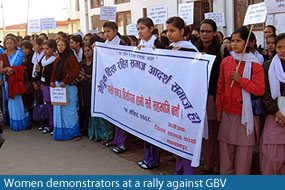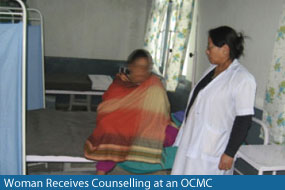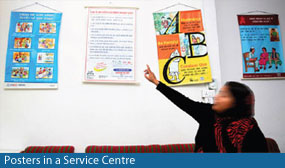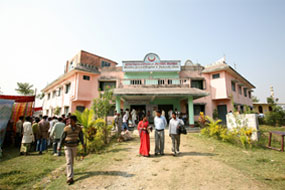What Works
1. One-Stop Crisis Management Centres
A practical approach to helping victims of gender based violence
- Gender Based Violence (GBV) is unacceptable and widespread - one in five women aged 15 to 49 years has experienced physical violence at least once since age 15
- GBV can result in long term physical, sexual and psychological damage
- GBV is one of the factors in the high rates of suicide among women of reproductive age
- When GBV occurs at home, victims may have no-one to turn to for help
- Women who have been trafficked or are destitute have nowhere to go for help
- Victims of GBV need practical help of different types, available in one safe place
- Levels of public awareness on GBV and its prevention need to be raised
In the last year, the Ministry of Health and Population (MoHP) has set up seven hospital based One-stop Crisis Management Centres (OCMC) to help female victims of gender based violence. Trained staff provide all the care needed in one place, including treatment of injuries, shelter, psychological counselling, help with rehabilitation or negotiation with the family, legal advice and protection. Over the next year at least eight more OCMCs are planned, in districts where Women and Children Offices have established service centres that offer counselling and shelter to GBV victims. The OCMCs will complement the service centres, providing more comprehensive “one-stop” care and working with them and local NGOs to ensure women know about the help available.
OCMCs are currently planned or in process at different levels of health facility:
Primary Health Care Centres
Dhulikhel, Kavrepalanchwok
District Hospitals
Sunsari, Panchtar, Solukhumbu, Sarlahi, Tanahu, Nawalparashi, Bardiya, Doti
Zonal Hospitals
Dhaulagiri, Baglung, Jumla, Kanchanpur, Saptari
Sub/Regional Hospitals
Makwanpur, Dang
Specialist Hospitals
Maternity Hospital, Kathmandu
 HOW ARE OCMCs SET UP?
HOW ARE OCMCs SET UP?In 2010 a National Action Plan against GBV was developed, led by the Prime Minister’s Office. A key point was the need for integrated services for GBV victims. MoHP was given responsibility for setting up services, coordinating with the Chief District Office, Women and Children Office, District Police, District Attorney’s Office and concerned local NGOs.
- In 2011, MoHP produced The Hospital Based One-Stop Crisis Management Centre Operational Manual which specified the services to be provided and management processes.
- As a first step, the hospital and local context is »assessed by a team from MoHP, Department of Women and Children and NHSSP, to ensure its suitability.
- A district level OCMC Coordination Committee is set up to manage the establishment and running of their OCMC, taking into account local needs.
- Service providers and OCMC coordination committee members are oriented on GBV, legal provisions and approaches to helping victims.
- Training in psycho-social counselling is provided to a focal person (usually the staff nurse), with further skills training as needed.
- The OCMCs will benefit individual victims of GBV, who will be able to access all the help they need in one place. Better access to legal support will strengthen their position and increase their confidence, enabling them to begin dealing with their problems.
- As public awareness grows more women will come to OCMCs for help, rather than suffering in silence and communities will be less tolerant of GBV and more likely to report cases.
- Nationwide, more action can be expected, to combat female trafficking and sexual harassment.
With NHSSP support, MoHP plans to:

- Monitor and review the pilot OCMCs to identify and act on any improvements needed
- Provide livelihood skills training at the OCMCs, so that GBV survivors can provide for themselves in the future and no longer depend economically on their abusers
- Develop a referral protocol, as cases with serious injuries or psychological trauma may need treatment at a more specialised centre, or require higher level legal advice
- Develop an information campaign to ensure people know about GBV, the OCMCs and how they can help
- Establish more OCMCs, so that women in all districts can access the help provided.
2. Reducing Construction Costs With NHSSP Inputs:
Standard Design Reduces costs:DIRECT COSTS
 Previously, different buildings for Health Posts, PHCC and District Hospitals were planned and constructed at different times, based on demand and available resources. Each building had its own support services, such as water supply and electrical systems etc. This led to very high overall construction costs and also had implications for repair and maintenance costs due to the non-integration of units and services and larger floor areas.
Previously, different buildings for Health Posts, PHCC and District Hospitals were planned and constructed at different times, based on demand and available resources. Each building had its own support services, such as water supply and electrical systems etc. This led to very high overall construction costs and also had implications for repair and maintenance costs due to the non-integration of units and services and larger floor areas. Integrating all the separate units into one single design, as is now done, leads to considerable cost savings in many areas.
Bidding Cost and human effort are largely reduced by having a single tender instead of several.
Construction Cost is reduced in many ways. Providing for central services saves money and space, reducing the need for expensive and scarce land. Space is appropriately planned, and designed for long term expansion. Economies of scale are gained in transportation, establishing the construction site, supervision, monitoring and the cost of tools and machinery.
Construction work is faster and cheaper with an integrated design because of having a single plinth area and less foundation work. The implementation cost of construction will also drop with time as the technicians learn the standard construction techniques, many of which can be replicated in similar conditions.
Small projects mean small contracts, with smaller inexperienced contractors, a poor quality of work and more expensive construction. For a larger integrated construction, an ‘A’ level contractor or even an International Competitive Bidder can be obtained, whereby better experience, technology and skills are used, resulting in better building quality and skill transfer and achieving economies of scale.
Support Service Costs are reduced since the same support service is used by all units. A single septic tank, retaining walls and service road can serve for all, with a huge saving in land development and support services.
In the past hardly any facilities were designed in an integrated way and buildings were located on an ad hoc basis, resulting in non-functional linkages between different units, and high service provision costs. At times, service provision became so difficult that buildings became non-productive and huge investments were left idle.
Under the latest integrated design, the entire administration can be handled by a smaller central unit, bringing great savings in everyday management, regular maintenance and repair work. In addition, these designs support both horizontal and vertical development, allowing for future expansion using the same service units constructed earlier.